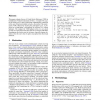Free Online Productivity Tools
i2Speak
i2Symbol
i2OCR
iTex2Img
iWeb2Print
iWeb2Shot
i2Type
iPdf2Split
iPdf2Merge
i2Bopomofo
i2Arabic
i2Style
i2Image
i2PDF
iLatex2Rtf
Sci2ools
ETRA
2004
ACM
2004
ACM
Visual deictic reference in a collaborative virtual environment
This paper evaluates the use of Visual Deictic Reference (VDR) in Collaborative Virtual Environments (CVEs). A simple CVE capable of hosting two (or more) participants simultaneously immersed in the same virtual environment is used as the testbed. One participant's VDR, obtained by tracking the participant's gaze, is projected to co-participants' environments in real-time as a colored lightspot. We compare the VDR lightspot when it is eye-slaved to when it is head-slaved and show that an eye-slaved VDR helps disambiguate the deictic point of reference, especially during conditions when the user's line of sight is decoupled from their head direction. 1 Motivation The lack of eye contact in tele-communication systems has long been recognized. Ishii and Kobayashi [1992] showed the importance of eye contact in shared drawing and conversation systems while Garau et al. [2001] demonstrated the importance of eye gaze in humanoid avatars representing people engaged in conv...
| Added | 20 Aug 2010 |
| Updated | 20 Aug 2010 |
| Type | Conference |
| Year | 2004 |
| Where | ETRA |
| Authors | Andrew T. Duchowski, Nathan Cournia, Brian Cumming, Daniel McCallum, Anand K. Gramopadhye, Joel S. Greenstein, Sajay Sadasivan, Richard A. Tyrrell |
Comments (0)

